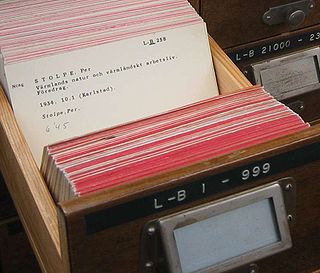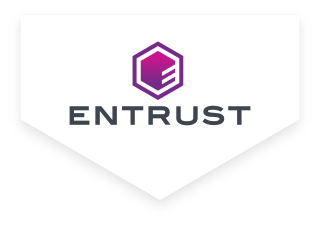ISO/IEC 7816 is an international standard related to electronic identification cards with contacts, especially smart cards, and more recently, contactless mobile devices, managed jointly by the International Organization for Standardization (ISO) and the International Electrotechnical Commission (IEC).

Secure Digital, officially abbreviated as SD, is a proprietary, non-volatile, flash memory card format the SD Association (SDA) developed for use in portable devices.

Near-field communication (NFC) is a set of communication protocols that enables communication between two electronic devices over a distance of 4 centimetres (1.6 in) or less. NFC offers a low-speed connection through a simple setup that can be used for the bootstrapping of capable wireless connections. Like other proximity card technologies, NFC is based on inductive coupling between two electromagnetic coils present on a NFC-enabled device such as a smartphone. NFC communicating in one or both directions uses a frequency of 13.56 MHz in the globally available unlicensed radio frequency ISM band, compliant with the ISO/IEC 18000-3 air interface standard at data rates ranging from 106 to 848 kbit/s.

An address book or a name and address book is a book, or a database used for storing entries, called contacts. Each contact entry usually consists of a few standard fields. Most such systems store the details in alphabetical order of people's names, although in paper-based address books entries can easily end up out of order as the owner inserts details of more individuals or as people move. Many address books use small ring binders that allow adding, removing, and shuffling of pages to make room.
Quantum Coorperation is a data storage, management, and protection company that provides technology to store, manage, archive, and protect video and unstructured data throughout the data life cycle. Their products are used by enterprises, media and entertainment companies, government agencies, big data companies, and life science organizations. Quantum is headquartered in San Jose, California and has offices around the world, supporting customers globally in addition to working with a network of distributors, VARs, DMRs, OEMs and other suppliers.

HSN, an initialism of its former name Home Shopping Network, is an American free-to-air television network owned by the Qurate Retail Group, which also owns catalog company Cornerstone Brands. It is based in the Gateway area of St. Petersburg, Florida, United States.

An index card consists of card stock cut to a standard size, used for recording and storing small amounts of discrete data. A collection of such cards either serves as, or aids the creation of, an index for expedited lookup of information. This system is said to have been invented by Carl Linnaeus, around 1760.

Ameristar Casinos, Inc. was a casino operator based in Paradise, Nevada. It was acquired by Pinnacle Entertainment in 2013. The company had eight properties in seven markets.
Coinstar, LLC is an American company operating coin-cashing machines.

Contactless payment systems are credit cards and debit cards, key fobs, smart cards, or other devices, including smartphones and other mobile devices, that use radio-frequency identification (RFID) or near-field communication (NFC) for making secure payments. The embedded integrated circuit chip and antenna enable consumers to wave their card, fob, or handheld device over a reader at the Point-of-sale terminal. Contactless payments are made in close physical proximity, unlike other types of mobile payments which use broad-area cellular or Wi-Fi networks and do not involve close physical proximity.
Arnold Neustadter was an American inventor and businessman. He invented the Rolodex desktop rotating card file and other office equipment with Danish engineer Hildaur Neilson, which has been called "a triumph of low technology" and "a lasting symbol of the art of networking".

Entrust Corp., formerly Entrust Datacard, provides software and hardware used to issue financial cards, e-passport production, user authentication for those looking to access secure networks or conduct financial transactions, trust certificated for websites, mobile credentials, and connected devices. The privately-held company is based in Shakopee, Minnesota and employs more than 2,500 people globally.
Bread Financial Holdings, Inc. is an American publicly-traded provider of loyalty and marketing services, such as private label credit cards, coalition loyalty programs, and direct marketing, derived from the capture and analysis of transaction-rich data.

Block, Inc. is a U.S. listed company founded by Jack Dorsey and Jim McKelvey in 2009. It is a financial technology conglomerate. The company reportedly serves 56 million users and 4 million businesses, and processes payments worth US$228 billion annually as of 2023.

Payoneer Global Inc. is an American financial services company that provides online money transfer, digital payment services and provides customers with working capital.

LendUp was an American online direct lender. It offered payday loans, installment loans, and credit cards to consumers with low credit scores using publicly available data to assess creditworthiness. The company referred to its customers as “the emerging middle class.” LendUp also issued credit cards in partnership with Tom Steyer's Beneficial State Bank.

Corpay, Inc. is a global business payments and spend management company that provides solutions that control expense-related purchasing and payment processes. Corpay is an S&P 500 company with a portfolio of brands that automate, secure, digitize and manage billions of payment transactions annually on behalf of businesses across more than 100 countries in North America, Latin America, Europe, and Asia-Pacific.

QIWI plc is a Russian company that provides payment and financial services in Russia and CIS countries. The group includes QIWI payment system, QIWI Bank, CONTACT money transfer system, Factoring PLUS, Flocktory, and RealWeb. The company has representative offices in three countries.

N26 is a German neobank headquartered in Berlin, Germany. N26 was founded in 2013 by the Rocket Internet incubator and currently operates in various European Union member states that are members of the Single Euro Payments Area (SEPA). N26 provides a free basic transaction account and a debit card, with overdraft and investment products and premium accounts available for a monthly fee.

The Flipper Zero is a portable Tamagotchi-like multi-functional device developed for interaction with access control systems. The device is able to read, copy, and emulate RFID and NFC tags, radio remotes, iButton, and digital access keys, along with a GPIO interface. It was first announced in August 2020 through the Kickstarter crowdfunding campaign, which raised $4.8 million. The first devices were delivered to backers 18 months after completion of the crowdfunding campaign. The device's user interface embodies a pixel-art dolphin virtual pet. The interaction with the virtual pet is the device's core game mechanic. The usage of the device's functions defines the appearance and emotions of the pet.






















